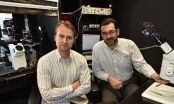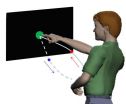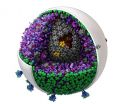Bisphosphonates had been associated by past studies with slowed tumor growth in some patients but not others, and the mechanism behind these patterns was unknown. In the studies published today, an international research team showed that bisphosphonates block the abnormal growth signals passed through the human EGF receptors (HER), including the forms of this protein family that make some tumors resistant to leading treatments. The connection between bisphosphonates in HER receptors was detected first in a genetic database analysis and confirmed in studies of human cancer cells and in mice.
"Our study reveals a newfound mechanism that may enable the use of bisphosphonates in the future treatment and prevention of the many lung, breast and colon cancers driven by the HER family of receptors," said lead study author Mone Zaidi, MD, Professor of Medicine and of Structural and Chemical Biology within the Icahn School of Medicine at Mount Sinai, Director of the Mount Sinai Bone Program and a member of the Tisch Cancer Institute at Mount Sinai. "Having already been approved by the FDA as effective at preventing bone loss, and having a long track record of safety, these drugs could be quickly applied to cancer if we can confirm in clinical trials that this drug class also reduces cancer growth in people. It would be much more efficient than starting drug design from scratch."
Of the two newly published PNAS papers, one describes the evidence that bisphosphonates block abnormal growth signals through HER family receptors, while the second examines the potential applications for this new mechanism: cancer prevention, combination with existing treatments, and use against treatment-resistant tumors.
Stop Abnormal Growth The study results revolved around the human epidermal growth factor receptor (HER/EGFR) family, which consists of four types of transmembrane tyrosine kinase receptors: HER1, HER2, HER3, and HER4. HER family members occur on the surfaces of many cell types and regulate cell division and proliferation, processes closely linked to both normal tissue growth and the abnormal growth seen in cancer.
A variety of human cancers, including nonsmall cell lung (NSCLC), breast, and colon cancers, are driven by random genetic changes (somatic mutations) that make HER family receptor tyrosine kinases more active drivers of abnormal growth. About of 30 percent of nonsmall cell cancers (NSCLCs) and 90 percent of colon cancers are driven by small genetic changes in HER1, while 25 percent of breast cancers proceed from genetic changes that result in excessive amounts of HER2.
Mechanistically, HER proteins are transmembrane tyrosine kinase receptors. To drive life processes, signals must travel between cells, arrive at cell surfaces, and be passed on inside cells. When a signaling molecule like a growth factor docks into a specially shaped receptor protein on a cell's outer surface, like a key into a lock, it changes shape of the receptor such that a biochemical message is passed on inside the cell to promote survival and growth.
In the case of a tyrosine kinase receptor, the docking of its signaling partner on the outside of the cell turns on its attached kinase inside the cell. Kinases partner with the molecule used as cellular energy currency, adenosine triphosphate (ATP), to attach a phosphate group to another molecule, which cells use like a switch to kick off chain reactions, some related to growth.
Dr. Zaidi and colleagues show that bisphosphonates themselves bind to the kinase domains of HER proteins, preventing the passing on of growth signals. For this reason, drugs that block the action of tyrosine kinases (inhibitors) like trastuzumab (Herceptin), erlotinib (Tarceva) and gefitinib (Iressa) have dramatically improved survival of cancer patients, but therapy for more than three years in a row invariably results in resistance.
By killing off cancer cells that specifically signal either through HER1 or HER 2 only, leading treatments create evolutionary pressure, and over time tumors come to be made up of more and more of cancer cells that have a second mutation that prevents binding of therapies to prevent growth. The current study suggests that bisphosphonates may block the function of HERs even when second mutations are present, and hence have the potential of treating cancers that have become resistant to primary therapy.
Detective Work Having seen that some people taking bisphosphonates have lower incidence of several cancers, the study authors analyzed the genes that become more or less active when a patient takes these medications using the Connectivity Map (cmap). The well-known database, built by The Broad Institute at MIT, analyzes connections between drugs, diseases and genes, and in particular, identifies genes that become active or inactive when people are treated with a given class of drugs.
Once the team detected a digital cmap link between bisphosphonates and the HER receptor, they conducted experiments in cancer cell cultures and mice that confirmed the potential value of treating HER-driven cancers with bisphosphonates alone, and in combination with an approved tyrosine kinase inhibitor in Tarceva (iritinib). Giving mice bisphosphonates early on prevented HER-driven tumors from forming in the first place. Combining bisphosphonates with the tyrosine kinase inhibitor not only stopped tumor growth in mice, but reversed it. In contrast, mice with colon cancer cells that do not signal for growth using HER receptors remained insensitive to bisphosphonate action.
"While this finding is exciting, there is no business model for conducting the costly clinical trials that would be needed to repurpose bisphosphonates for cancer," said Dr. Zaidi. "Pharmaceutical companies are unlikely to pay for research to develop generic drugs where there is no chance of patent protection or profit, so we will be looking for a non-traditional funding source, perhaps the federal government."
INFORMATION:
About the Research Team
Authors on both PNAS papers, along with Dr. Zaidi, in the Departments of Medicine, Pediatrics, and Chemical and Structural Biology; and in the Tisch Cancer Institute with the Icahn School of Medicine at Mount Sinai; were Tony Yuen, Agnes Stachnik, Jameel Iqbal, Yogesh Gupta, Ping Lu, Graziana Colaianni, Yaoting Ji, Ling-Ling Zhu, Se-Min Kim, Jianhua Li, Peng Liu, Sudeh Izadmehr, Jaya Sangodkar, Shiraz Mujtaba, Solomon Epstein, Aneel Aggarwal, Maria New, Li Sun and Goutham Narla. Study authors also included Miriam Sgobba and Shozeb Haider in the School of Pharmacy at University College in London, Alberta Zallone of the Department of Histology at the University of Bari in Italy, and Zhuan Bian in the School of Stomatology at Wuhan University in China.
Mount Sinai authors only on the first paper, "Repurposing of bisphosphonates for the prevention and therapy of nonsmall cell lung and breast cancer," were Thomas Scherer, Matthew Galsky, Jorge Gomez, and Christoph Buettner. Mount Sinai authors only on the second paper, titled "Bisphosphonates inactivate human EGFRs to exert antitumor action," were Jack Bailey, Yathin Latif, and Terry Davies.
The work was supported by grants from the National Institutes of Health (DK80459, AG40132, AG23176, AR06592, and AR06066), the Italian Space Agency, the National Science Foundation of China, the National Center for Advancing Translational Science through Mount Sinai School of Medicine's Clinical and Translational Science Award, and a Howard Hughes Medical Institute Physician-Scientist Early Career Award (KL2TR000069).
About the Mount Sinai Health System
The Mount Sinai Health System is an integrated health system committed to providing distinguished care, conducting transformative research, and advancing biomedical education. Structured around seven member hospital campuses and a single medical school, the Health System has an extensive ambulatory network and a range of inpatient and outpatient services--from community‐based facilities to tertiary and quaternary care.
The System includes approximately 6,600 primary and specialty care physicians, 12‐minority‐owned free‐standing ambulatory surgery centers, over 45 ambulatory practices throughout the five boroughs of New York City, Westchester, and Long Island, as well as 31 affiliated community health centers. Physicians are affiliated with the Icahn School of Medicine at Mount Sinai, which is ranked among the top 20 medical schools both in National Institutes of Health funding and by U.S. News & World Report.
For more information, visit http://www.mountsinai.org, or find Mount Sinai on Facebook, Twitter and YouTube.



